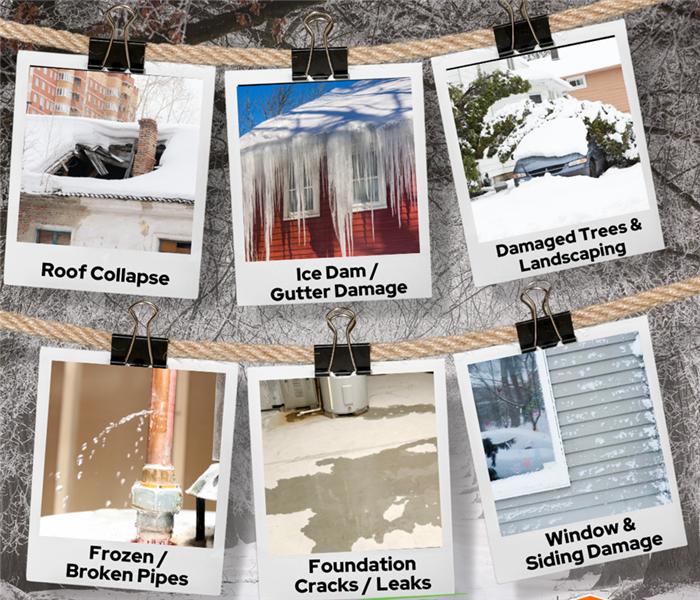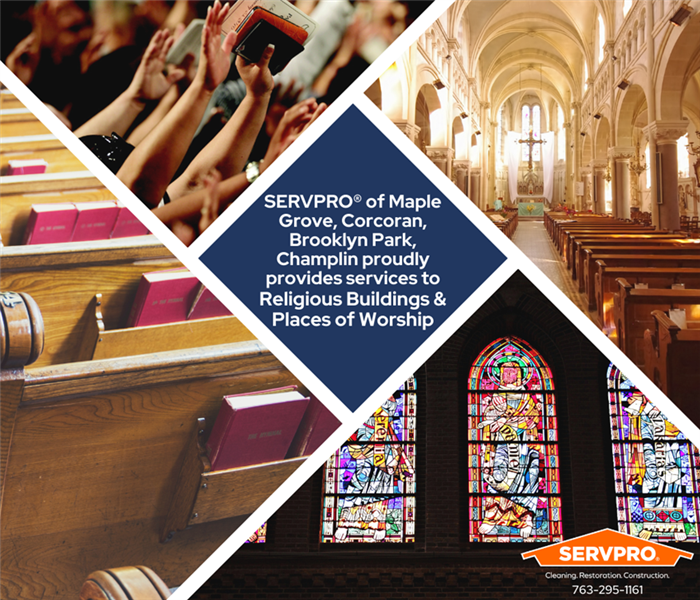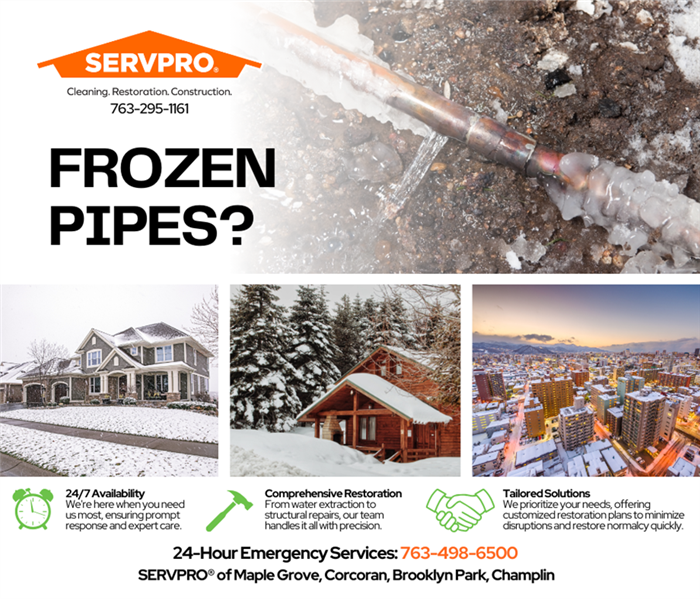Recent Posts
Snow, Rain, and Ice Damage
3/25/2024 (Permalink)
 Snow, rain, and ice can wreak havoc on your home or business!
Snow, rain, and ice can wreak havoc on your home or business!
With significant snowfall and rain expected in the coming days, it's essential to remain alert to protect your property. Snow and ice pose various threats to both homes and businesses:
1?? Roof Damage: Heavy snow can strain roofs, causing collapse or structural issues. Ice dams may lead to leaks.
2?? Frozen Pipes: Low temperatures can freeze and burst water pipes, causing flooding.
3?? Gutter Damage: Ice buildup in gutters can block drainage, causing leaks and fascia damage.
4?? Foundation Cracks: Freeze-thaw cycles can crack foundations.
5?? Siding Damage: Ice and snow can lead to cracks and moisture issues.
6?? Tree and Landscaping Damage: Heavy snow can cause tree limbs to damage property.
7?? Window and Door Damage: Ice buildup can damage seals, leading to drafts, leaks, and misalignment.
Don't forget: SERVPRO of Maple Grove, Corcoran, Brooklyn Park, Champlin is here round the clock for any winter emergencies. Reach out to us anytime at ?? 763-295-1161.
Religious Buildings & Places of Worship
2/20/2024 (Permalink)
 SERVPRO of Maple Grove, Corcoran, Brooklyn Park, Champlin provides specialized services to religious buildings and places of worship.
SERVPRO of Maple Grove, Corcoran, Brooklyn Park, Champlin provides specialized services to religious buildings and places of worship.
Did you know that SERVPRO of Maple Grove, Corcoran, Brooklyn Park, Champlin offers specialized services for places of worship? Whether it's a church, mosque, synagogue, or temple, we understand the importance of preserving these sacred spaces for congregants and communities alike.
Our dedicated team is equipped to handle a wide range of cleaning, restoration, and construction needs, ensuring that your place of worship remains a welcoming and safe environment for all who enter its doors. From water damage restoration to fire damage cleanup, we're here to help you overcome any challenge so that you can focus on what matters most: serving your congregation and spreading love and positivity.
Contact us today to learn more about how we can support your faith community!
SERVPRO of Maple Grove, Corcoran, Brooklyn Park, Champlin proudly provides services to: Maple Grove, Corcoran, Brooklyn Park, Champlin, Dayton, Rogers, Osseo, and surrounding areas.
5 Tips for Water Mitigation - Commercial
1/25/2024 (Permalink)
Water has the potential to wreak havoc on a commercial building within a short timeframe. To mitigate the damage effectively and prevent secondary issues like mold growth, it is crucial to promptly address standing water and residual moisture.
Consider the following five essential tips for water mitigation and cleanup:
Remove Standing Water: The initial step in tackling water damage involves eliminating standing water using portable pumps or a wet vac. Professionals specializing in water damage mitigation can swiftly and comprehensively extract water while offering valuable cleaning tips for both building materials and contents.
Enhance Airflow: Restoration experts may recommend deploying ventilation equipment such as air movers or fans to facilitate drying. Ventilation proves particularly effective when addressing clean water introduced by a pipe burst. However, caution is advised in areas exposed to contaminated water for an extended period, as circulating air may spread spores.
Explore Heated Drying Methods: In certain situations, the use of heat can expedite the drying process. The level of contamination, duration of damage, and the materials affected play crucial roles in determining the most suitable drying methods. Restoration professionals can provide tailored advice based on the specific circumstances.
Control Humidity Levels: humidity reduction discourages fungal growth.
Wait for Complete Drying: Commencing rebuilding or restoration should be postponed until the water-damaged portion of the structure has been thoroughly cleaned, disinfected, and dried. This includes the replacement of any contaminated building materials that were removed during the mitigation process.
If your home or business has water damage, contact the pros at SERVPRO® of Maple Grove, Corcoran, Brooklyn Park, Champlin as soon as possible! Our crews are available 24-hours a day by calling 763-498-6500.
5 Tips to Prevent Frozen Pipes
1/23/2024 (Permalink)
 Home, cabin, or commercial property - SERVPRO® of Maple Grove, Corcoran, Brooklyn Park, Champlin can help!
Home, cabin, or commercial property - SERVPRO® of Maple Grove, Corcoran, Brooklyn Park, Champlin can help!
Minnesota winters can be harsh, and when faced with a cold snap, the risk of burst pipes in our homes and businesses become a concern. Internal pipes are susceptible to bursting when the water within them freezes and expands, exerting excessive pressure.
To prevent this scenario, consider these five tips for safeguarding your home:
Enhance Air Circulation: Pipes within areas like kitchens and bathrooms, often situated on exterior walls behind cabinet doors, can benefit from the warmth inside. Open these doors to allow warm air in.
Insulate At-risk Pipes: Use insulation or heat tape to keep vulnerable pipes warm and protected.
Daily Faucet Running: Ensure all faucets are run daily, especially those with cold pipes. Continuous water flow prevents freezing.
Maintain Consistent Heating: While a lower heating bill is tempting, it's crucial to keep your home consistently heated above at least 55 degrees during cold spells. Avoid the potential damage and expenses associated with burst pipes.
Seal unused spaces: In areas like attics and crawl spaces, add insulation if possible. If not, seal off gaps under doors, windows, and other cracks to minimize heat loss.
In case of a pipe burst, SERVPRO® of Maple Grove, Corcoran, Brooklyn Park, Champlin is available 24/7 to provide assistance, give us a call at 763-498-6500. Additionally, contact your insurance agent promptly to assess coverage for any resulting damage. Stay safe and warm!
SERVPRO® of Maple Grove, Corcoran, Brooklyn Park, Champlin provides services to the following cities: Maple Grove, Corcoran, Rogers, Dayton, Osseo, Greenfield, Brooklyn Park, Champlin, and surrounding area.
Whatever Disaster Strikes at Your Business, SERVPRO is Here
6/8/2022 (Permalink)
We are the premier service professionals ready to help your business in even the biggest jobs. Fire, water, mold, we can handle it.
When a fire happens, it can bring your business to a sudden halt. Thankfully, SERVPRO is available 24 hours a day, seven days a week and 365 days a year. When a fire happens, give us a call so we can get you back to normal and up and running as soon as possible.
Whether it’s a leaky pipe or like the flood gates opened and there is water everywhere, SERVPRO has you covered. We have the highest quality equipment available so you can get everything up and running in no time.
Noticing a foul odor? Starting to see dark spots? Well, you might have a mold problem. Don’t fret, SERVPRO can help. We are experts at mold remediation. Your business is safe with us.
3 Helpful Things To Know About Flood Insurance
5/20/2022 (Permalink)
Flood Insurance
When looking at commercial insurance policies for a Maple Grove, MN business, many company owners may be wondering if flood insurance is a good choice for their property. Here are a few things to consider.
1. What May Be Covered
In most cases, a flood policy will cover damage caused by nature or accidents. This usually includes incidents such as a broken pipe or sewer backup, along with rain overflow and other storm damage. It is the policy holder’s responsibility to know exactly what their plan covers, but most normal flooding falls under these categories. In many cases, the insurance provider may also cover the cost of repair and cleanup, as well as recommend a professional restoration service.
2. What May Not Be Covered
Many commercial insurance policies will not cover flooding that comes as a result of neglect. This means that if you knew one area needed repairs, you failed to take action, and flooding occurred as a result, then your insurance provider may decline coverage.
3. What a Restoration Company Can Do
Insurance providers may have recommendations for a restoration company that may be able to help. A professional restoration service is equipped to help with large-scale disasters according to FEMA guidelines. They also offer services such as electronic inventory management system, which can be used to document items and repair requirements as they go. The database can be updated by the restoration team and accessed by the insurance agents allowing them to have the most up-to-date information as they keep track of the claim.
When looking at their commercial insurance policy, it's up to the policyholder to know what exactly is included. In most cases, flooding caused by accidents or natural disasters will be covered. Flooding caused by neglect, however, probably will not. A professional restoration team may have the tools necessary to work with the insurance company in order to help process the claim and keep all required information updated.
Prepare your Commercial Building for a Winter Storm
5/16/2022 (Permalink)
Take These Steps To Prepare Your Building for a Winter Storm
As the first winter weather of the season rolls into Minnesota, it could be too late to consider winterizing your building. Being proactive is key when it comes to potential storm damage. As cooler temperatures approach, it’s a good time to go over last-minute details before the cold sets in. Consider taking these steps to prepare your building for a winter storm:
1. Inspect the Roof
Get your roof professionally inspected before the first signs of winter weather. Damaged flashings and loose or missing shingles could result in severe damage to the interior of the building if left to sit through the winter.
2. Cut Back Tree Limbs
Ice and snow really weigh down tree limbs. Be sure to trim back overhanging, loose or dead branches before winter weather hits. Otherwise, you risk damage to your roof, windows, gutter system, among other things.
3. Clean Gutters
A winter storm can wreak havoc on a gutter system. Make sure to keep gutters free of all leaves and debris. A combination of full gutters and snow can form ice dams which can cause interior damage.
4. Inspect Insulation and Weather Stripping
Make sure that your building has a sufficient amount of insulation and weather stripping. They can make all the difference when it comes to the cost of your heating bill.
5. Leave the Heat On
Leave the heat on even in areas that aren’t being used. Set the thermostat to no lower than 55 degrees Fahrenheit.
6. Inspect HVAC System
Get a full HVAC inspection before cold weather arrives. This will ensure that everything is in proper working order before the need for heat arises.
7. Inspect Exposed Pipes
Make sure that the pipes are properly insulated to protect them from freezing and bursting. By sealing any cracks or openings you will go a step further to prevent a pipe break.
When it comes to winter in Maple Grove, MN being proactive can ultimately save time and possibly even a lot of expense. If your building sustains damage from a winter storm, be sure to call storm cleanup professionals to help.
Emergency Preparation: Ensuring Commercial Generators are maintained
5/12/2022 (Permalink)
A generator is a pivotal piece of machinery for many businesses, especially medical and manufacturing practices. These tools ensure that a business can maintain operations in the event of a power failure, and whether for safety concerns or production value they must be maintained. Failure to perform adequate maintenance can lead to a litany of issues, but there are four that are the most common.
1. Battery Failure
The leading cause of generator problems is battery failure. Failure occurs because a battery has not been charged properly or it needs to be replaced due to age. Most failures can be avoided by making sure that all cables, chargers and batteries are checked regularly and that their condition remains in good standing.
2. Leaks
Generator leaks are common and usually preventable through routine maintenance. These leaks can occur in the fuel, oil or coolant lines. Those leaks occurring in the coolant line are likely due to a block in the hoses leading to the heater. However, all leaks are preventable with regular checkups.
3. Low Fuel
Another common problem is faulty fuel gauges leading to low fuel. In order to avoid this issue, you can get in the practice of manually checking fuel tanks and having additional fuel storage on hand at your facility.
4. Starting Issues
If your machine is not set to auto, then it will not start up when a power outage occurs. However, if this is not your issue, then you can try a manual reset of the system. If that fails to work, then you can contact a storm preparedness specialist in the Maple Grove, Corcoran, Brooklyn Park, Champlin area to figure out other possible causes.
A generator can be a potential life-saver, both figuratively and literally, for many business owners. However, these machines do have their kinks and must be regularly maintained to function correctly in the event of an emergency.
The Top 4 Recommended Locations for Fire Alarms in Your Home
5/12/2022 (Permalink)
Fire Alarms In Your Home
While you might assume that when you bought your home in Maple Grove, Corcoran, Brooklyn Park, or Champlin that it came already installed with all the smoke alarms you need to keep your family safe, this is not always the case. As more research has been conducted over the years on fires and how they spread, requirements have changed. Many older homes do not meet these standards which can be dangerous in the case a fire does occur. Keep your family safe by ensuring a fire alarm is located in the following four locations!
1. Bedrooms
The National Fire Protection Association suggests the placement of a fire alarm in every bedroom of the house. This ensures that if a fire occurs while your family is asleep, the alarms will wake quickly wake up everyone.
2. Outside Every Sleeping Area
Not only should alarms be inside every bedroom, there should be a smoke alarm right outside the room or any other sleeping areas as well. This is so you can react and start to escape before any fire or smoke even enters your room.
3. 10 Feet From Your Kitchen
Kitchen fires result in approximately 50 percent of all home fires, many of which result in serious fire damage to your home. Make sure a fire alarm is located 10 feet from your kitchen rather than inside it since smoke or steam from cooking can easily trigger it.
4. Every Level of Your Home
Ensure that there is as least one smoke alarm on every level of your home. Don’t forget your basement! Serious fire and smoke damage can occur from an undetected fire that starts in the basement.
It doesn’t take long for a house fire to quickly get out of hand! That’s why it is so important to have all the required fire alarms installed so you can quickly get everyone out of your house and get in contact with the fire department and a fire restoration company to minimize the fire damage to your home.
Mold Has an Appetite for Fine Art
5/12/2022 (Permalink)
Artwork poses a difficult challenge when it comes to mold cleaning. The usual mold remediation and prevention techniques won’t work. You can't:
- Abrasive-blast the mold away with baking soda
- Treat the moldy area with chemicals and paint
- Throw it away
- Make the environment inhospitable
Mold and Oil Paintings Both Like Warmth and Moisture
A home with low relative humidity inhibits mold growth. Unfortunately, it also damages oil paintings. Both do very well when the relative humidity is 45 percent. They also enjoy a room temperature of 70 degrees Fahrenheit. Displaying your artwork in this environment makes it susceptible to mold.
Mold Cleaning of Paintings Is Simple for the Experts
Art restoration is a science unto itself. Its practitioners often restore paintings that are centuries old. These paintings may show damage, neglect, or need cleaning. The removal of mold is one of the many tasks they perform on a regular basis.
With your moldy oil paintings, there is one question. How important are they to you? A family heirloom deserves expert attention. If it's a painting you don't care as much about, mold removal might be an interesting experience. There are four simple steps:
1. Place the painting in the sun for a few hours and let it dry completely
2. Taking care not to damage the paint, don a mask and brush away the dried mold using a soft brush
3. Using a weak bleach solution, treat the moldy areas with a light spray
4. Return the painting to the sun for drying
Moldy Artwork May Point to a Bigger Problem
Finding mold damage on an oil painting is not a cause for panic. It suggests that it is time to check the rest of your home. Look for signs of mold in wet, damp or humid areas.
Further signs of infestation mean that you are due for mold cleaning. You will locate a team of mold remediation experts in the Maple Grove, Corcoran, Brooklyn Park, Champlin area who can move in and address the problem. They can also find someone to restore your paintings.




 24/7 Emergency Service
24/7 Emergency Service


